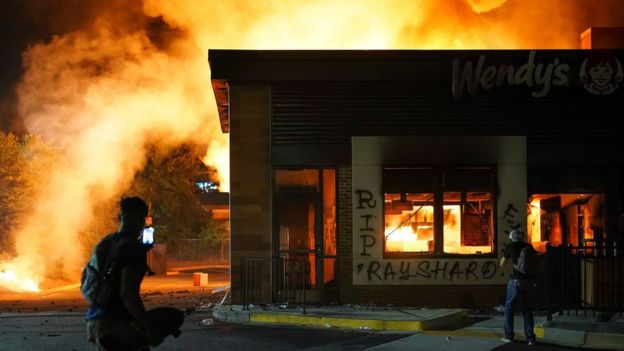Turmoil gripped the city of Atlanta Saturday night following the death of Rayshard Brooks. Protesters shut down Interstate 75 for a time, and the Wendy’s where Brooks was killed was burned down. The unrest comes on the heels of 3 weeks of protest following the officer-involved killing of George Floyd.
The Killing of Rayshard Brooks
Brooks was shot and killed Friday night following an incident in the Wendy’s drive-through. Police were called after Brooks fell asleep behind the wheel, forcing other patrons to drive around him. Brooks failed a field sobriety test and was placed under arrest.
Police allege that Brooks resisted arrest. He can be seen on video struggling with officers and even running away at one point. Brooks apparently got hold of one of the officer’s tasers and pointed the weapon at the officers. It was at this point that he was shot and killed.
Atlanta Mayor Keisha Lance Bottoms said she believes the use of deadly force was not appropriate. Atlanta police chief Erika Shields resigned Saturday as a result of the shooting. The officer who fired the shot was fired, and another officer is under investigation.
National Implications
The death of Rayshard Brooks is sure to fuel protests which were already showing little signs of abating. While local municipalities and some states have adopted a few police reforms, there has been little movement on the national level. Democrats introduced some legislation, but it has little chance of passing the Republican-controlled Senate.
Republicans are looking into the matter as well. Senator Tim Scott, the lone African American Republican in the Senate, is leading their efforts. He too has rejected Democratic proposals but has yet to announce his own.
The Rayshard Brooks case is different than the Floyd case or the Breonna Taylor case, and it raises different questions. In the Floyd and Taylor cases, unarmed black citizens were killed by police. Neither was resisting arrest. Brooks was resisting arrest and even managed to get one of the police officer’s weapons.
The case shows the difficult choices facing the nation in the coming weeks and months. Where do we draw the line on the use of deadly force? When is it appropriate?
One thing that is clear is that these two issues, police brutality and systemic racism, have to be dealt with. The fact that these events have unfolded during an election year could make a difference this time around. The death of Rayshard Brooks ensures that the energy behind the movement will not subside.


